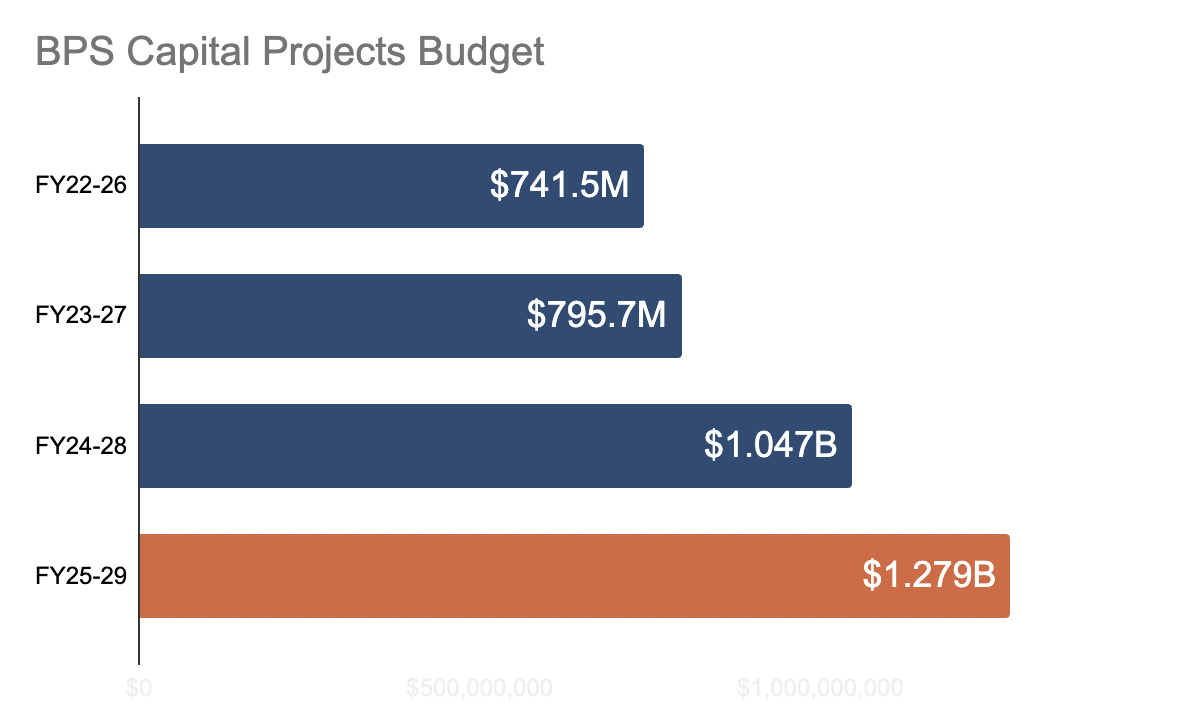FYI from BSF, 4.12.24
While spending and revenue dominated coverage of the proposed city budget this week, Wednesday’s release included billions of dollars that will matter for many years: the capital budget.
As a division of the local government, school districts like Boston Public Schools (BPS) don’t have their own capital budgets; BPS projects are a portion of the ~$4.7B that also has to cover things like repaving parking lots by playgrounds and new fire stations.
And unlike the BPS operating budget passed by School Committee a few weeks ago, the capital budget covers multiple years; five, to be precise. Many projects require more than a year of funding and labor, and each year new projects are finished, new projects come on, older debt is retired, new debt is taken on, etc.
The last two mayoralties have made big promises about schools facilities, with Mayor Walsh and BuildBPS and now Mayor Wu and the Green New Deal for BPS. The newly released FY25-FY29 capital budget gives some insights into where things stand.
1. There are a lot more projects in the budget.
2. There is a lot more money for capital projects in BPS.
Half a billion dollars more. +72% increase in a few short years.
This coincided with an infusion of dollars from two sources: (1) American Rescue Plan (ARPA) pandemic recovery dollars that supported a host of city services and capital projects and (2) a $350M general obligation bond offering. The former is nearly all spent; the latter nearly tripled the city’s debt service requirements (see table on page 8).
3. There is a lot more left money to spend.
At of the close of last year, less than 10% of dollars allocated to BPS capital projects had actually been spent.
4. The majority of new capital dollars are tied up in major renovations.
The figure is even greater when coupled with Athletic Facility, which includes the renovation of White Stadium.
5. Schools in every neighborhood have benefited from the increase in activity.
Some more than others, but keep in mind the distortion caused by singular, expensive projects and timing. Fenway-Kenmore looks “cut” here, but that is only because the brand new Boston Arts Academy building is done and paid for. Projects like the new Quincy Upper School (Central), the overhaul of the Madison Park campus (Roxbury), a new building for the Shaw-Taylor merger (Mattapan) loom large in neighborhood spending.
6. Things change.
Anything can happen in five years, so it is natural for some projects to never come to light, and new ones to emerge. Some projects carry on even when their viability is unclear; the West Roxbury Educational Complex still has $18M+ allocated for a project even though the O’Bryant is not moving there.
Since the long-term facilities plan for BPS submitted to the state does not include specific projects and timelines, the annual capital budget process is likely the vehicle for communicating these decisions.
On the long list, there are two projects not like the other 70, the two projects without a specific renovation, school, or neighborhood identified. Together, these two projects dedicate $104M to major renovations, supporting “grade reconfigurations” or “implementation of the long-term facilities plan.”
So, probably more to come here.
notes in the margin
Boston School Committee met Wednesday. Full materials here, including the renaming of the BCLA-McCormack in honor of Ruth Batson.
Most principals or teachers have an odd story about an MCAS administration, but this may be the winner.
Good summary of the House version of the MA budget, which includes a lot more money for education.
Schools have more coaches now.
The average tenure for superintendents has declined by 50%.
Chicago’s bet its pandemic dollars on tutoring, and it appears it worked.
The “bookends” of PK-12 - early child care and colleges and universities - face a similar dilemma: increasing costs that don’t translate to better staff compensation. Update on the C3 child care grant program and why BU graduate students are striking.
Little seems to be getting in the way of the creation of the “Tuition is Too Damn High” political party. First, very hard to apply for financial aid this year.
UMass tuition is up. Polling data indicates many New England residents are questioning the value-add of attending college.
This graph, from Bloomberg, seems to validate that skepticism.
A lot of blue circles below that line, but there are schools like Baruch College breaking the trend.
A local liberal arts college is reinstating its SAT admissions requirement.








